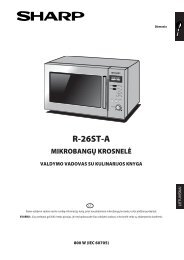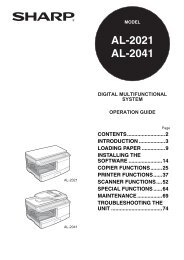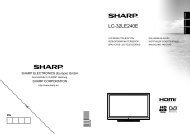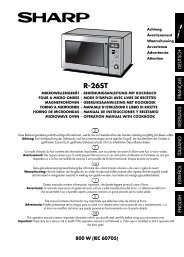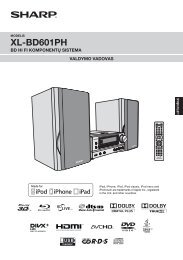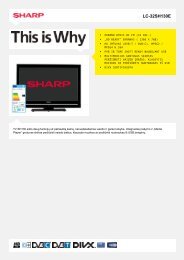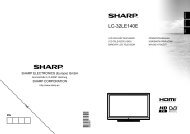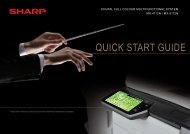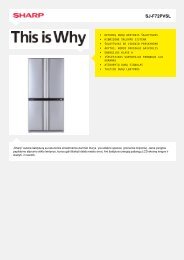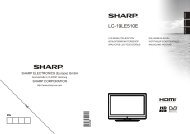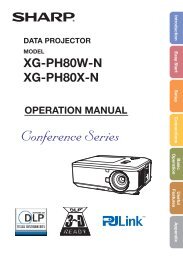R-879 Operation-Manual GB - Sharp
R-879 Operation-Manual GB - Sharp
R-879 Operation-Manual GB - Sharp
Create successful ePaper yourself
Turn your PDF publications into a flip-book with our unique Google optimized e-Paper software.
R-<strong>879</strong>_[EN].qxd 5/2/08 6:40 PM Page 3<br />
IMPORTANT SAFETY INSTRUCTIONS<br />
Other warnings<br />
Never modify the oven in any way.<br />
Do not move the oven while it is in operation.<br />
This oven is for home food preparation only and<br />
may only be used for cooking food. It is not<br />
suitable for commercial or laboratory use.To<br />
promote trouble-free use of your oven<br />
and avoid damage.<br />
Never operate the oven when it is empty except<br />
where recommended in the operation manual, see<br />
Page <strong>GB</strong>-8. Doing so may damage the oven.<br />
When using a browning dish or self-heating<br />
material, always place a heat-resistant insulator<br />
such as a porcelain plate under it to prevent<br />
damage to the turntable due to heat stress.<br />
The preheating time specified in the dish’s<br />
instructions must not be exceeded.<br />
Do not use metal utensils, which reflect microwaves<br />
and may cause electrical arcing. Do not put cans<br />
in the oven.<br />
Use only the turntable designed for this oven.<br />
Do not place anything on the outer cabinet during<br />
operation.<br />
Do not use plastic containers for microwaving if the<br />
oven is still hot from using the GRILL,<br />
CONVECTION, DUAL, INSTANT ACTION and<br />
AUTOMATIC operation (except AUTO DEFROST),<br />
because they may melt. Plastic containers must not<br />
be used during above modes unless the container<br />
manufacturer says they are suitable.<br />
NOTE:<br />
If you are unsure how to connect your oven, please<br />
consult an authorised, qualified electrician.<br />
Neither the manufacturer nor the dealer can accept<br />
any liability for damage to the oven or personal<br />
injury resulting from failure to observe the correct<br />
electrical connection procedure.<br />
Water vapour or drops may occasionally form on<br />
the oven walls or around the door seals and<br />
sealing surfaces. This is a normal occurrence and is<br />
not an indication of microwave leakage or a<br />
malfunction.<br />
INSTALLATION<br />
1. Remove all packing materials from the inside of the<br />
oven cavity. Discard the loose polythene sheet from<br />
between the door and cavity. Remove the feature<br />
sticker, if attached, from the outside of the door.<br />
4. The oven door may become hot during<br />
cooking. Place or mount the oven so that<br />
the bottom of the oven is 85 cm or more<br />
above the floor. Keep children away<br />
from the door to prevent them burning<br />
themselves.<br />
✓<br />
Remove<br />
this film<br />
2. Check the oven carefully for any signs of damage.<br />
5. Do not allow the power supply cord to<br />
run over any hot or sharp surfaces,<br />
such as the hot air vent area at the top<br />
rear of the oven.<br />
6. Ensure there is a minimum of free space above the<br />
oven of 19 cm.<br />
3. Place the oven on a flat, level surface strong<br />
enough to support the oven’s weight plus the<br />
heaviest item likely to be cooked.<br />
This oven is designed for countertop or built-in use.<br />
Do not place the oven in a cabinet. When building<br />
the oven into a kitchen unit, see "To avoid the<br />
danger of fire" on page <strong>GB</strong>-1.<br />
7. Securely connect the plug of the oven to a<br />
standard earthed (grounded) household electrical<br />
outlet.<br />
ENGLISH<br />
<strong>GB</strong>-3



